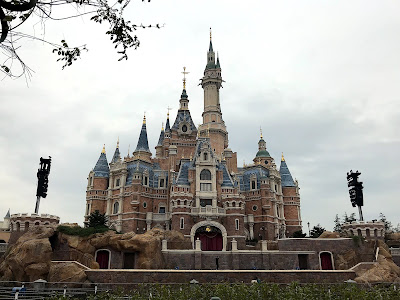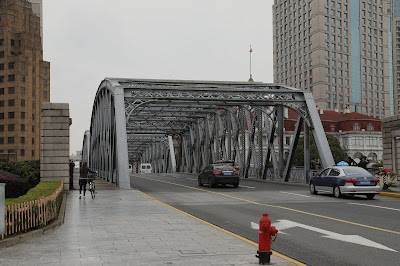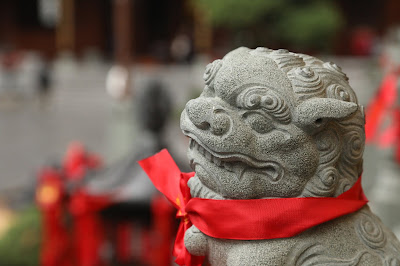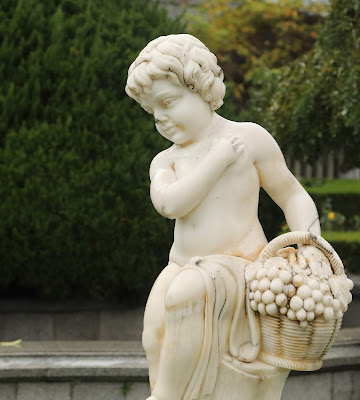Good Morning Campers here at Woody and Buzz’s Hotel. Yes I am enjoying the theme as Toy Story is KEWL!!!
Anyway, I was up early to do a bit of a walkabout of the Hotel to take some more pictures and find an ATM. As I have said and I will say it again the theme here is nice. For a Disney hotel it is more low key and not in your face theme. I have noticed the Green Army Men have yet to be found in any of the art work. The elevator is one of the fastest and smoothest I have been in and the Little Green Aliens letting me know we have reached the 8th floor is fun.
Like any other Disney Property, there is a flurry of morning staff cleaning away to prepare for the upcoming day.
The weather was a bit drizzly and cool, but not cold. I am expecting cloudy wet weather during our stay.
Lynn is sleeping and when she gets up we will have some coffee and breakfast and then be off to find the Metro station to start our day in Shanghai.
We enjoyed coffee and oatmeal in the room as we prepared for the day activities. We bundle up and make our way to the Shuttle bus which will take us to the metro station.
Upon our arrival, the quest for a metro ticket began. The vending machines only sell a one trip ticket, so we had to wait till 0800 for the ticket office to open. We purchased a 3 day Metro Pass, about $7.00, thinking we may return to visit The Bund one evening for the lights.
The Metro, like any other large city particular in Asia, is an experience many may want to avoid. The term Personal Space is not evident, replaced push and shove and cram while getting swept away with the crowd.
Waibaidu Bridge.
It is said one has not visited Shanghai till one has seen the Waibaidu Bridge.
Waibaidu Bridge is one of the landmarks of the old city of Shanghai, spanning the Suzhou Creek, and at the confluence of this creek with the Huangpu River. It is the earliest and largest steel bridge in the city, stretching from north to south. In addition of its traffic function, the bridge, joining the north end of the Bund and facing the rippling Huangpu River, serves as a view point for visitors to enjoy the splendid skyline of Pudong. Going through over 100 years, Waibaidu Bridge has witnessed the vicissitudes of Shanghai.
About 150 years ago, with no bridge over Suzhou Creek, the only way to get across was by ferry. Because of the settlement of foreign concessions on two sides, the ferry couldn't cope with the increasing passenger volume. So, a British businessman named Wills directed the building of a large wooden bridge, Wills Bridge, beyond the river in 1856. Folks called it Waibaidu because it was located at the Outside Ferry (Waibaidu). Chinese had to pay to cross the bridge, and this triggered off a storm of protest. In order to calm the masses, a wooden bridge, named Garden Bridge, was built to the west of it, free to the public. Later, the old bridge was demolished. In 1908, a steel bridge was constructed to replace the wooden bridge so as to allow streetcars over the river.
The Bund
For a century, the Bund has been one of the most recognizable symbols and the pride of Shanghai. The architecture along the Bund is a living museum of the colonial history of the 1800s. You've never been to Shanghai if you haven’t seen the Bund.
Coming to Shanghai and missing the Bund is like visiting Beijing and bypassing the Forbidden City or the Great Wall.
What impress travelers most should be the 52 buildings with various international architectural styles which makes the Bund “An Exhibition of International Buildings”. There is no doubt that the Bund is the fusion of Western and Chinese Culture, an epitome of Shanghai’s history, and a great place to explore Shanghai’s today and see the future of Shanghai.
The name “Bund” in Anglo-Indian term means “the embankment of a muddy waterfront”. To know Shanghai, you must come to Shanghai Bund. Before the 1840s, Shanghai was a small seaside town and the Bund was once a muddy towpath for boats along Huangpu River. After First Opium War in 1842, Shanghai began to be an open port and later the Bund was the first settlement of Great Britain. Many foreign powers entered Shanghai and erected their distinct Western-style banks and trading houses from the United Kingdom, France, the United States, Italy, Russia, Germany, Japan, the Netherlands and Belgium, as well as the consulates of Russia and Britain, etc. In the later part of 19th Century and 20th Century, Shanghai grew into Asia’s leading city, a cosmopolitan and thriving commercial and financial center. Known as “Oriental Wall Street”, the Bund was a historical miniature of colonial-era Shanghai.
I hope to return again to visit The Bund at night as the lights of the skyline are beautiful. We have been lucky to have dined at The M on The Bund one evening years ago.
Shanghai Old Street
While we had a bit of difficulty finding Shanghai Old Street, all the streets from the Bund to Yu Garden are old and a flurry of local activity. Yes even in the cold rain.
Shanghai Old Street, historically called Miaoqian Dajie, is an old business street that has a combination of tourist attractions, shops, entertainment and cultural exhibits. It owes its special social attractions and rich commercial background to the fact that the earliest bank, gold shop, jeweler's store, wine shop and tea house of the city were all to be found here.
The architecture and the layout of shops in Shanghai Old Street show its development that began during the Ming Dynasty (1368-1644) until the period when European influence made an impact on the city. The western part of this old street begins at South Henan Road and continues to Guanyi Street. The buildings here reflect the style of the Ming and Qing (1644-1911) dynasties and the architecture is elegant in its classic simplicity. Red poles, pink walls and black roofs with upswept eaves are in harmony with the buildings in Yu Garden. The eastern end of Shanghai Old Street, with a length of 500 meters (about 1,640 feet) ends at Renmin Road and after reconstruction and decoration retains the residential characteristics of later Qing Dynasty. The swing doors reach to the ground, the lattice windows and the graceful roofs with upswept eaves are fascinating as they are precisely how foreigners imagine China to be. Although there are several European buildings, they don't contradict the styles of old Shanghai. On the contrary, they are a vital part of the diverse culture here.
There are about 225 stores on Shanghai Old Street, each designed carefully according to its function. Shops purveying handicraft articles, paintings, calligraphies and jewelry are well-appointed and give you plenty of variety from which to choose what you want. On the eastern part, old shops such as the Tong Han Chun Pharmacy, Lao Tong Sheng Food Store, Wu Liang Cai Glass Shop, De Shun restaurant, take you back to the Shanghai of 100 years ago. In the Chun Feng De Yi Lou teahouse, you can enjoy Yuanbao Tea served with two olives in it.
By the way, you can visit Yu Garden, which is a famous classical garden next to Shanghai Old Street. Here you will find the Temple of the City God, a Taoist temple and Chen Xiang Pavilion, a Buddhist temple are also in Yu Garden Tourism Zone.
Old City God Temple enjoys a high status in Shanghai, with an old saying: one who fails to reach the temple never reaches Shanghai. City God Temple was built to protect the safety of the people in the city, and the gods are regarded as patron saints in Taoism.
The Old City God Temple was built in Yongle Reign of Ming Dynasty (1368 - 1644), the Old City God Temple of Shanghai, commonly known as Chenghuangmiao by locals, is located at Middle Fangbang Road, and adjoins Yu Garden in the south. With the commercial development, and the surrounding trade region expanding, the numbers of shopping centers and snack streets are increasing rapidly. As a result, today's Old City God Temple usually refers to an area stretching from Anren Street in the east, to Fuyou Road in the north and Old Xiaochang Road westward.
The Old Town God Temple of Shanghai, with far-reaching history, attracts a lot of tourists from all over the world to visit. With an area of 2,000 square meters (2,390 square yards), the present temple includes nine palaces - Huo Guang Palace, Sixty-year Cycle Palace, God of Fortune Palace, Cihang Palace, City God Palace, Empress Palace, Parents Palace, Guansheng Palace and Wenchang Palace. The Temple enshrines three town gods: Huo Guang a famous general of Western Han Dynasty (202 BC- 9 AD), Qin Yubo, a celebrity of Yuan Dynasty (1271 - 1368), also known as a dutiful son. It is said that he constructed a palace that imitated the style of the emperor's throne room, which his mother desired to see. When the emperor learned about this, he sent an officer to investigate, so Qin Yubo transformed the palace into a temple to escape punishment. After his death, he appeared in a war leader's dream and warned him to give up a massacre, so the people of this city were saved. The other is Chen Huacheng, sacrificed in the First Opium War (1839 - 1842). As well as the three main gods, four departments were set up to protect the city.





Nanxiang Steamed Buns with Stuffing is particularly famous in Shanghai and there is a branch at the end of Nine Bend Bridge. The buns are soft and juicy with thin skin. Nanxiang Steamed Buns is my favorite and our lunch/snack.
After our snack we made or way across the crooked bridge to Yu Garden. We have visited this garden before yet with every visit we make a new discovery. Entry is 30 Yuan, but 1/2 price for us folks over 60.
Yu Garden, aka Yuyuan Garden, Yu Yuan in Chinese, is a classical garden ranking among the must-see attractions in Shanghai. It dates back to the Ming Dynasty (1368-1644) and was owned by a government officer named Pan Yunduan. Yu in Chinese means pleasing and satisfying, and this garden was specially built for Pan's parents as a place for them to enjoy a tranquil and happy time in their old age.
Yu Garden is small in size, but it contains all elements that a classical Chinese garden should have. The pavilions, halls, rockeries, ponds and cloisters all have unique characteristics. There are some highlights in the garden that you can't miss.
Great Rockery
Upon entering Yu Garden, you will encounter a rockery, which is called the Great Rockery. With a height of 14 meters (about 50 feet), it is the largest as well as the oldest rockery in the southern region of the Yangtze River. On the top of the rockery, you can get a bird's eye view of the garden.
Cuixiu Hall
Cuixiu Hall sits at the foot of the Great Rockery. It is a quiet and elegant place surrounded by old trees and beautiful flowers. Visitors can find curio shops in the Cuixiu Hall.
Sansui Hall
Sansui Hall was originally used to entertain guests. Later it became a place to hold ceremonies for the gentlemen and bookmen. With a height of nine meters (about 30 feet) and featuring five halls, it is the most commodious structure in the garden. The name Sansui is derived from the book History of the Later Han Dynasty, and means 'propitious' and 'lucky'.
Wanhua Chamber
Wanhua Chamber is a delicate building surrounded by derious cloisters. Spring bamboos grow beside the cloisters. In front of Wanhua Chamber, there are two old trees. One is a ginkgo which is 21 meters tall (about 70 feet). It is said that the tree was planted by the owner of Yu Garden 400 years ago.
Exquisite Jade Rock
The true treasure of Yuyuan is the Exquisite Jade Rock, one of the three most famous rockeries in south China. The rock is 3.3 meters (about 10.8 feet) in height and has 72 holes. What is interesting about this rock is that if you burn a joss stick just below the rock, the smoke will magically float out from all of the holes. Similarly, when you pour water into the rock from top, the water will flow out from each hole creating a spectacular sight to see. Yuhua Hall facing the rock was built particularly for appreciating it. The furnishings in the hall were made of top grade rosewood of the Ming Dynasty, appearing both natural and graceful.
Jade Buddha Temple
In the western part of Shanghai, a very modern and flourishing city, there is a venerable and famous Buddhist temple, Jade Buddha Temple. In 1882, an old temple was built to keep two jade Buddha statues which had been brought from Burma by a monk named Huigen. The temple was destroyed during the revolution that overthrew the Qing Dynasty. Fortunately the statues were saved and a new temple was built on the present site in 1928. It was named the Jade Buddha Temple.
The two precious jade Buddhist statues are not only rare cultural relics but also porcelain artworks. Both the Sitting Buddha and the Recumbent Buddha are carved with whole white jade. The sparkling and crystal-clear white jade gives the Buddhas the beauty of sanctity and make them more vivid. The Sitting Buddha is 190 centimeters high and encrusted by the agate and the emerald, portraying the Buddha at the moment of his meditation and enlightenment. The Recumbent Buddha is 96 centimeters long, lying on the right side with the right hand supporting the head and the left hand placing on the left leg, this shape is called the 'lucky repose'. The sedate face shows the peaceful mood of Sakyamuni when he left this world. In the temple there is also another Recumbent Buddha which is four meters long and was brought from Singapore by the tenth abbot of the temple in 1989. Furthermore there are many other ancient paintings and Buddhist scriptures distributed in the different halls here.
Although the history of the Jade Buddha Temple is not very long, the old-time and classical architectural style makes it unique and inimitable in this modern city. Devajara Hall, Mahavira Hall and the Jade Buddha Tower make up the main structure of the temple and at sides are the Kwan-yin Dian Hall, the Amitabha Dian Hall, the Zen Tang Hall, the Dining-Room and the Recumbent Buddha Hall. The Sitting Buddha is in the Jade Buddha Tower and the Recumbent Buddhas are in the Recumbent Buddha Hall. More than 7,000 Dazang sutras are kept in the Jade Buddha Tower; these are all the inestimable culture relics.
The Jade Buddha Temple is a good place to go whether you are a Buddhist or not, the peaceful and transcendent atmosphere adds a kind of richness to our busy modern society.
Fuxing Park
Can be a the place where many locals come to relax, play cards, dominoes, fly kites, dance, Tai Chi and exercise. Today, because of the rain, we found the park very empty, yet still a pleasant place to visit.
The construction of Fuxing Park combines French-style and Chinese-style layout. The north and central parts of the park focus on the French-style layout and includes the Carpet Flower Bed, Central Fountain Pool and China Rose Flower Bed. The southwestern part of the park presents the Chinese-style layout and includes the Rockery, Lotus Pond, stream, winding path and lawn. In general, the French construction style is the dominant style of the park as it was initially constructed and designed by the French. The following are some beautiful landscapes you can visit in the park:
Rockery
The Rockery or Artificial Hill sits in the southwestern part of Fuxing Park and covers 1,850 square meters (2210 square yards). The Rockery is a manmade hill made up of stone blocks and covered with green trees. On the top of the Rockery is a pavilion where you can have a bird’s-eye-view of the whole park.
Lotus Pond
To the northeast of the Rockery, lies the Lotus Pond. The pavilions and corridors stand beside the pond in harmony. Walking to the northeast of the pond, you can see a small pond separated from the lotus pond by a dam and shaded by a big Platanus tree. It’s definitely worth a look.
China Rose Garden
The China Rose Garden is located in the northwestern part of the park with an area of around 2,700 square meters (3,200 square yards). The center of this oval garden is a round pond with a fountain and a statue of a goose-breeding girl. The ground around the pond is separated into four areas with different patterns which are planted with grass and thousands of China Roses.
Carpet Flower Bed
The Carpet Flower Bed, between the west road and east road of Fuxing Park, presents a rectangle shape. It is also called the French Sunken Flower Bed as the whole flower bed is lower than the surrounding area. The height difference allows people to have a birds-eye view of the whole flower bed. The big flower bed is divided into pictorial flower beds by various paths, covered with grass. Different flowers bloom in each of the four seasons, forming all kinds of colorful pictures. Viewed from afar, it appears like a wonderful brocade or a beautiful carpet. When the fountain opens, water sprays skyward accompanying the colorful flowers and green grass, beautiful and peaceful.
Statue Square
Statue Square lies to the north of the Carpet Flower Bed, and is famous for its Statues of Marx and Engels, which were built in 1985 for the 90th anniversary of Engels’ death. The statue, made up of three slabs of granite, weighs 70 tons, and is 6.4 meters (6.9 yards) high by 3 meters (3.2 yards) wide. The base and paths which lead to the statue are all constructed of granite. Walking on the square, you can see the verdant land beside the statue where lush cedars and green grass grow with beautiful flower beds inside.
Old Tree
Planetrees (trees from around the globe) grow throughout Fuxing Park. Those over 50 years old number over 1,700. Among them, one beside the south gate is the most famous, and is called “Shanghai No.2” for its huge body. This big tree grows strong with huge branches by careful trimming and cultivation. In addition to the big trees, there are some other famous trees, like a European Horse Chestnut blossoming every year, a bush named vitex negundo in the south gate, oriental white oak, and others, rarely seen in Shanghai.
In addition to those beautiful landscapes, there are other quiet secluded nice places awaiting your visit.
On the South Side of Fuxing Park we find Boxing Cat Brewery - A location I have recommended to many other travelers.
The Boxing Cat Brewery is one of the first and the most internationally recognized microbreweries in China. Established in 2008 in Shanghai, they now have over 3 brewpub locations and 1 central factory in Minhang. Over the years they have won best American restaurant, best bar, best brewery, best beer selection, best brunch, well, just about every best you could have! If one desires a bit of American comfort food and a great craft beer. Boxing Cat is where to go. We enjoyed their Pork Sliders and did something I rarely do, buy a T-Shirt.
We then walked back to the metro station and started the journey back to our hotel.
It was a wet windy enjoyable day, Lynn’s VivoFit indicated we had walked 13 miles.










































































